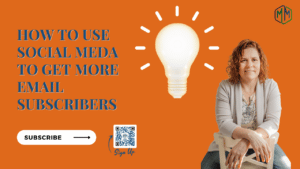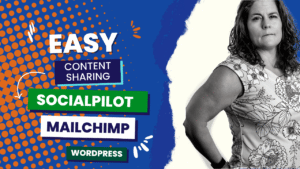
Email Newsletters are just one component of email marketing and are typically the easiest to execute for a new business or a business owner that is new to email marketing. Getting leads and consumers to sign up for your email newsletter is key to a successful program but getting them to stay is also just as important. One of the main reasons people unsubscribe from an email newsletter is receiving too many emails (Epsilon) from a company.
There is no one rule for sending for all types of companies. How often people purchase or repurchase your products and services will define how often to send email newsletters. The more often people purchase the more tolerant they are of getting frequent emails from you and are less likely to unsubscribe to your email newsletter.
Importance Of Email Newsletter In Your Marketing Mix
Email Newsletters provide you a way to stay in front of customers and leads to increase sales over time with a low cost to run the program. The average ROI for an email newsletter campaign is that you earn $40 for every dollar you spend on a campaign (Constant Contact). There are many factors that go into this:
- 100% of your emails are delivered to valid subscribed addresses. This makes awareness greater in email marketing than in social media which only shows your content to less than 2% of followers on average.
- Full control over design and brand elements.
- Full control over frequency, date, and time of sends
- A/B testing of content and language built into the email system
- Built-in unsubscribe, CanSpam, and GDRP requirements when using an Email System
- Track opens, clicks, and unsubscribes to a named account for deeper analytics
Since you reach more people more often in the inbox you don’t have to produce as much content as you do for social media. Also, you know based on data who your more engaged people are on your list. This allows you to create targeted campaigns with offers to the right audience for greater profits.
How Often To Send An Email Newsletter
Purchasing cycles in your industry and specific business model is the best place to start to figure out how often you should send out email newsletters to your list. Every industry and business will vary even where you are doing business in the world will factor into how often you should send emails.
The below table is a guide for where to start.
| Business Industry | Purchasing Cycle | Email Sending Frequency |
| Fashion Brands | Several Times A Month | Daily |
| SaaS Business Model | 1x Purchase | Monthly |
| SaaS Business Model | Subscription Based | Bi-Monthly |
| Pet Services | Monthly | Bi-Monthly |
| Retail Consumables | Monthly | Daily |
| Retail Consumables | Quarterly | 2x Per Week |
| Trades | As Needed, Emergent and Seasonal | Bi-Monthly |
| Realtors | In Frequent | Monthly |
| Financial Advisors | Reoccurring Services | Daily |
| Insurance | 1st time purchase and renewals | Monthly |
| Health Care Services | As Needed, Emergent and Seasonal | Bi-Monthly, with weekly during peak times (i.e. flu season) |
For an email newsletter an unsubscribe rate between 3% – 12% is standard (Constant Contact). These rates also vary by industry business types and whether your list is just opt-ins or a cold email list from an external source.
When you use an email marketing system like MailChimp or Constant Contact you can input your industry business type and get even better unsubscribe comparisons because both of these products provide real data from the over 200 million emails sent from their systems.
This is why we recommend to all of our clients to Sign Up for a Constant Contact Or Mailchimp account when doing email marketing. They both provide unsubscribe comparisons plus more against their real-world data.
Once you have 3 – 6 months’ worth of send data you can then start to tweak your frequency of sending email newsletters. If you are within the acceptable range for your industry you can continue to keep sending at the current frequencies. You push the boundaries and test the frequency to see if your unsubscribe rate stays the same or only raises slightly but your open and click-through rates increase. You should back off the frequency if you see your unsubscribe rates go up with your open rates go down.
Once you have locked in the frequency then you can start testing headlines, images, and content to determine how well your messages and content are doing. Listen to Inkyma’s Marketing Strategies podcast episode all about A/B testing and why it’s important.
Best Day & Time To Send An Email Newsletter
The Day and Time you send an email newsletter greatly impacts how quickly it is opened. Since the majority of email opens happen within the first 48 hours of sending you to want to do all you can to maximize your initial open rates.
As a whole, the best days to send emails are Tuesday, Wednesday, and Thursday with Tuesday being the best day out of the three. This can vary depending on your industry, your list, and what you are sharing in your email newsletter.
For example, if you are a realtor and sharing open house information, sending your emails on Fridays and Saturdays makes more sense when your open houses are on Sundays. It gives people on your list time to plan and they are in a house-hunting mindset rather than a work mindset making them more likely to open and take action on your email.
When you sign up for a MailChimp account you can use their Send Time Optimization Tool. Based on the data that Mailchimp collects on open and click-through rates they recommend the best time of day for your emails to go out.
If you are using another system the industry average shows the best time of day to send emails is general 2 pm. This again is dependent on the industry and the information you are sharing.
If your email newsletter is a daily stock performance report then it may be better to send this after 4 pm each day after the markets have closed.
Balance Email Newsletters with Other Emails In Your Marketing Mix
Email Newsletters are not the only tactic you should use in your email marketing strategy. Mixing in sales funnels, welcome emails and other types of emails will help you achieve a higher ROI on your email marketing. When you are implementing new email campaigns be aware of the timing for all of your emails, not just the newly launched one.
Frequency in email sends is about all of your emails, not just one campaign if you are emailing to the same list. You don’t want a group that you have decided to email only once a week to get 3 emails in a week because you have 3 different campaigns all sending at the same time.
We recommend that you keep a marketing calendar with all your email campaign send dates on it so that when you create something new you can balance your frequency of the new campaign with your existing campaigns. If you are using an email system like MailChimp or Constant Contact they have a calendar feature built-in so you can see what has already gone out and anything you have scheduled. But if you have automation running that doesn’t show up on the send calendar so we still recommend keeping a separate calendar that tracks your automation as well as your scheduled sends.
I hope you found this article helpful in securing your business so you can stay focused on your growth goal which always includes marketing. Feel free to reach out via chat if you have any questions. We are always happy to answer questions. If you want our content delivered to your inbox Sign up for our newsletter. You get great content and exclusive offers by being a member.
If you like this article, consider sharing it with other business owners you know. Use the sharing links below.






